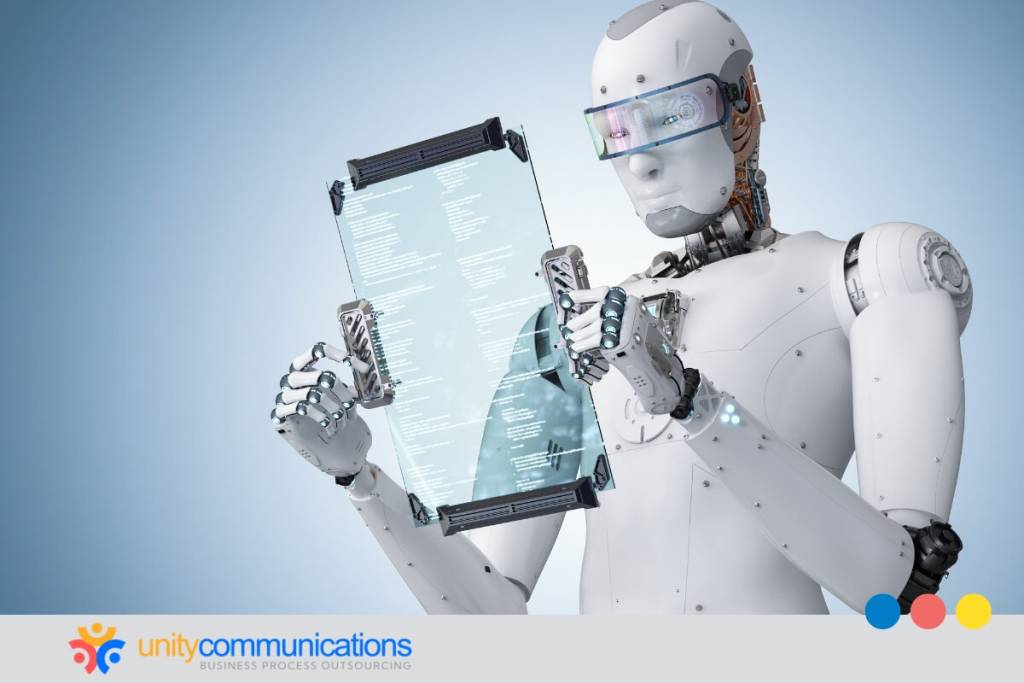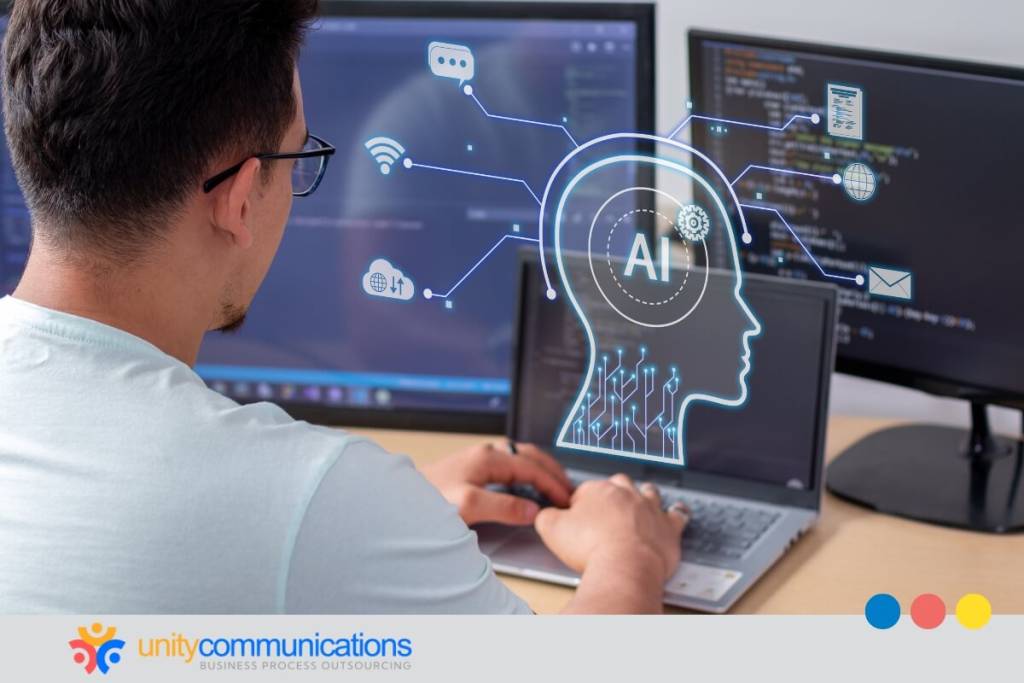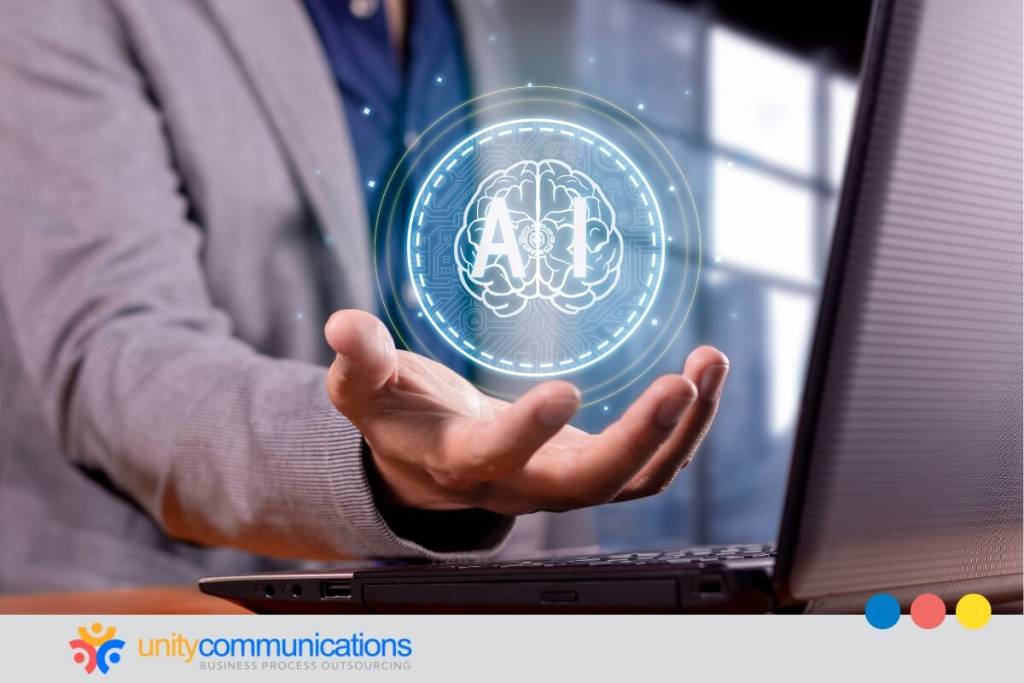Table of Contents
Artificial intelligence (AI) has now become a teammate that works alongside you. Today’s AI agents can set goals, break them into tasks, and act independently. They draft proposals, analyze data, and manage projects.
If you are a business leader or professional, understanding these agents is critical. The earlier you adopt them, the sooner you will save time, cut costs, and boost productivity.
This article will walk you through real-world AI agent examples so you can spot fit, reduce cost, and boost productivity faster.
What makes AI agents different from traditional AI?
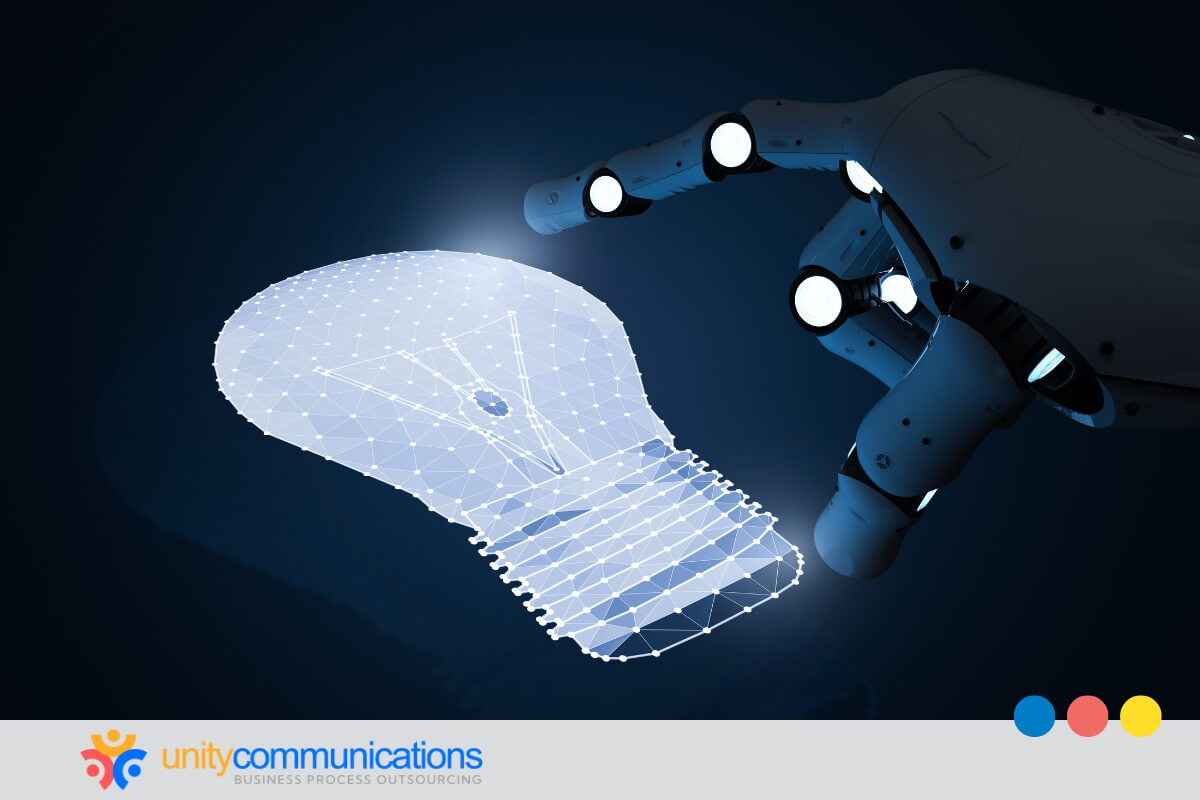
You’ve likely used AI before in chatbots, voice assistants, or apps, including ChatGPT. But AI agents go further. They can perceive a situation, reason about it, plan next steps, take action, and evaluate the outcome.
In short, they handle projects the way you would, instead of just answering a single question.
The real power here is autonomy. For example, if you ask a chatbot to “research competitors,” it would give you a quick answer. An AI agent would break the request into steps:
- Gather data.
- Compare results.
- Create an outline.
- Produce a full report.
That is why many AI agents feel more like digital colleagues than passive tools. Research shows the momentum is real. According to Deloitte’s 2024 Global AI Study, 79% of executives believe the technology will be critical to their business strategy within the next three years.
For you, this means AI agents are not just optional add-ons. When used correctly, they can cut costs, boost productivity, and help you stay ahead of competitors who are already experimenting with these tools.
Below, we explore the most exciting AI agent examples you can try today and uncover the technology that makes them work.
1. AutoGPT: The pioneer of autonomous AI
AutoGPT was one of the first AI agents to go viral, and for good reason. It demonstrated how a language model could run in a loop, setting sub-goals, evaluating progress, and continuing until it achieved a larger mission.
Technically, it combines GPT-4 or GPT-3.5 with a controller that manages planning and memory. It stores results in a vector database, utilizes application programming interfaces (APIs) or plugins to interact with external tools, and continues looping until it completes all tasks.
For many, it was the first time they had seen an AI system behave autonomously:
- You give it a broad objective.
- The system automatically breaks that goal into smaller steps.
- It then creates tasks, executes them individually, and feeds the results into its own reasoning process.
- This loop continues until the agent decides the mission is complete or can no longer progress.
This architecture gives it autonomy, but it can also drift or become stuck, highlighting the potential and limitations of first-generation agents. Prompting AutoGPT feels more like giving directions to a teammate than typing short chatbot questions.
Instead of saying, “Summarize this,” you might write, “Research the top five marketing strategies for startups in 2025 and prepare a short report with sources.” AutoGPT then plans out the tasks, such as finding data, reviewing sources, and drafting summaries, without requiring your guidance at each step.
Businesses experimenting with AutoGPT saw potential in automating long, repetitive workflows. Instead of prompting an AI 20 separate times, you could give it one mission and let it handle the details.
With global AI adoption expected to grow 20% and reach 378 million users by 2025, AutoGPT’s success demonstrates the rapid adoption of autonomous agents in mainstream use.
2. BabyAGI: Transparent task management made simple
BabyAGI is another early pioneer, designed to be simpler and more structured than AutoGPT. Instead of running indefinitely, BabyAGI uses a task queue to prioritize and complete goals one at a time. This makes it easier for you to follow along and understand what the agent is doing step-by-step.
One of the key benefits of BabyAGI is transparency. You can see how it creates tasks, ranks them, and determines the next steps. That makes it an ideal learning tool for newcomers to AI agents. It demonstrates how autonomy can be applied in a controlled and predictable manner, providing confidence before transitioning to more complex setups.
Technically, BabyAGI operates on top of a language model similar to GPT-4, but it relies heavily on a task management loop. It:
- Generates a to-do list
- Prioritizes tasks based on relevance
- Stores context in memory
- Executes each one in order
This structure limits infinite loops and makes debugging easier, which is why it’s often recommended as a safer starting point than AutoGPT. For businesses, BabyAGI became a helpful entry point into agent adoption.
By showing how a task manager AI could streamline operations, it inspired new use cases, including research assistance, project tracking, and even lightweight decision-making. As one of the most approachable AI agent examples, it continues to serve as a stepping stone for anyone curious about AI autonomy.
3. AgentGPT: A no-code AI agent example for everyone
Not everyone has the time or technical skill to set up AI agents from scratch. AgentGPT makes the experience accessible to everyone. Through a simple web interface, you can create an agent, give it a name, assign it a goal, and watch it execute.
It’s one of the most user-friendly AI agents available for the following reasons:
- AgentGPT uses a no-code approach. You don’t need to install libraries, configure frameworks, or write long prompts. Instead, you focus on what you want done, and the agent takes care of the rest. This has made the tech popular among professionals who want to test ideas without a heavy technical lift.
- It packages the same looped architecture as AutoGPT into a cloud-based service. It integrates GPT models with memory, planning modules, and API connections. However, it simplifies the setup, allowing you to see a clean interface. This makes it less flexible for developers but far more approachable for non-technical users.
For businesses, AgentGPT lowers the barrier to experimentation. Instead of relying solely on developers, teams across marketing, operations, and finance can try agents themselves. The democratization of such technology highlights how you can rapidly adopt these tools and leverage them without specialized knowledge.
4. LangChain Agents: The developer’s toolkit for custom AI
LangChain is less of a single agent and more of a framework for building agents. It’s the backbone for many of the AI agent examples you’ll see across startups and enterprises. With LangChain, developers can create agents that use memory, access tools, and orchestrate multi-step workflows seamlessly.
What sets LangChain Agents apart is flexibility. You can design agents that fetch data from APIs, analyze it, and then write a structured report all within one flow. The framework handles the “thinking” steps, deciding which tool to use and when. That’s why it has become the go-to toolkit for serious AI projects.
On the technical side, LangChain provides abstractions for:
- Chains (step-by-step processes)
- Agents (dynamic decision-makers)
- Memory (short- and long-term context)
- Tools (external APIs or functions)
This modular approach allows developers to mix and match components to build agents, such as tailored assistants, for specific business tasks.
If you’re a business leader, you don’t need to learn LangChain yourself. However, you should know that many custom agents your competitors are experimenting with are built on it. It’s one of the foundational types of AI agents that proves the future of automation is not about single tools but about ecosystems.
5. SuperAGI: Multi-agent orchestration for enterprise scale
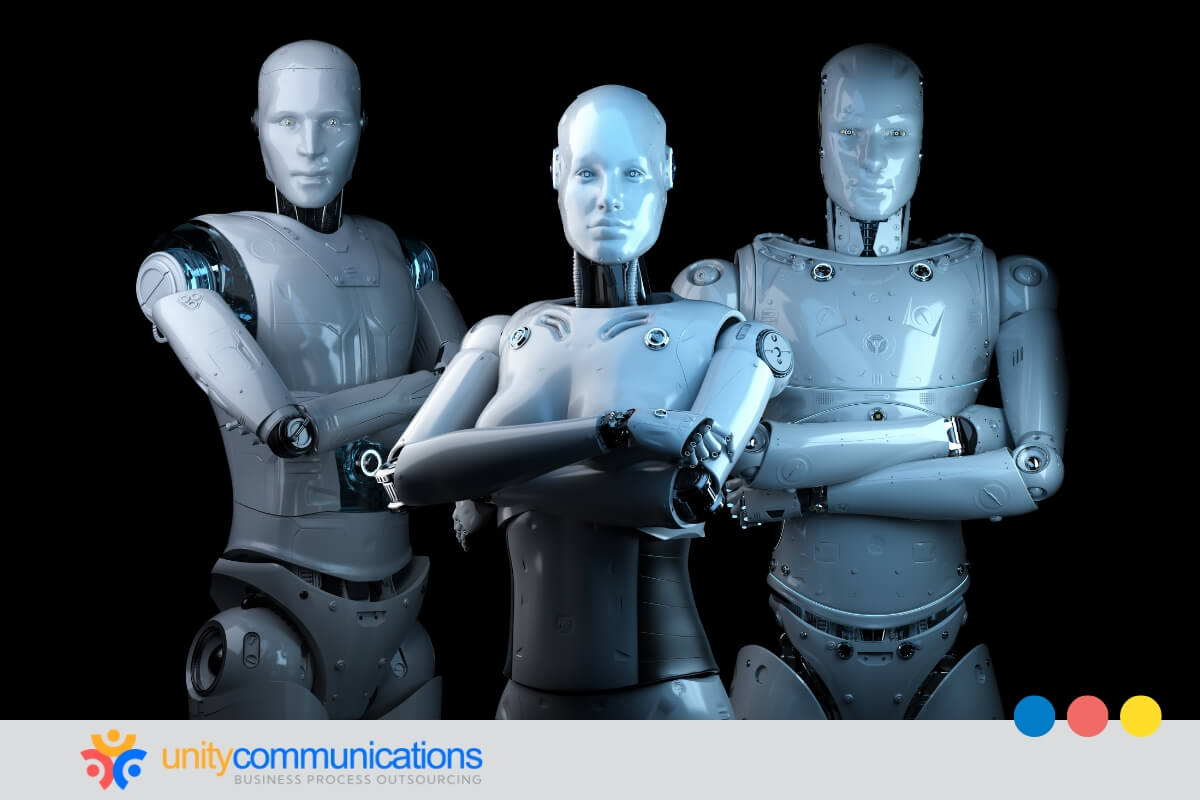
SuperAGI takes AI agents to the enterprise level. Instead of focusing on a single agent running tasks, it enables multiple agents to work in coordination. This makes it one of the most advanced AI agent examples for large-scale operations.
Think of it as an orchestration system for agent “teams.” What makes SuperAGI powerful is its scalability. You can create agents with specialized roles. One could be handling data retrieval, another summarizing results, and another generating final outputs. They work together like coworkers.
This type of collaboration enables the handling of projects that would overwhelm a single agent. From a technical perspective, SuperAGI is designed with a microservices architecture. It integrates LLMs, vector databases, API connectors, and orchestration modules to let agents operate as a coordinated system. It also includes monitoring and debugging tools, allowing enterprises to trust and manage agents at scale.
This means a glimpse of the future workplace: not just humans collaborating but humans and agents working side by side, each playing to their strengths. SuperAGI shows how AI will evolve from being an assistant to being part of your organization’s actual workflow.
6. CAMEL AI: Role-playing agents for strategic decision making
CAMEL AI takes a different approach to agent design by emphasizing multi-agent role play. It enables agents with diverse personalities and objectives to collaborate and solve complex problems. This makes it one of the most creative and collaborative AI agent examples you can explore.
The value of CAMEL AI lies in diversity. Just like in human teams, having different viewpoints leads to richer discussions and better solutions. CAMEL agents can challenge each other’s assumptions, refine their reasoning, and deliver results that feel more balanced and well-thought-out.
Technically, CAMEL AI is built around structured role-play prompts and a multi-agent coordination loop. Each agent is assigned a role (such as “CEO” or “engineer”) and provided with context. It then interacts with the others to debate, negotiate, and refine their outputs.
This structure allows it to simulate teamwork and produce higher-quality solutions for complex tasks. For businesses, you can apply CAMEL AI during
- Brainstorming sessions
- Simulations
- Scenario planning
Imagine an agent acting as a CFO debating with another agent acting as a CEO about financial strategies.
The same approach can also support industries, including business process outsourcing, where multiple specialized agents can collaborate to streamline customer support, back-office operations, or analytics tasks.
7. Godmode: Transparent AI agent operations
Godmode offers a highly visual experience for running agents. Instead of black-box operations, it allows you to observe agents’ steps in real time. You can see the reasoning process, decisions made, and tasks executed. This transparency makes it one of the most practical AI agent examples for testing and iteration.
Observing how an agent works builds trust. You don’t need to wonder what’s happening behind the scenes. You can see it unfold. That’s a significant advantage if you’re deploying agents in environments where accountability is crucial.
Under the hood, Godmode:
- Works as a user interface (UI) layer on top of open-source agent frameworks such as AutoGPT and BabyAGI
- Doesn’t invent new technology but packages existing loops into a dashboard, making it easier to visualize how an agent reasons and executes.
This layer of transparency turns experimentation into a collaborative process.
For teams, Godmode acts as a bridge between technical and non-technical users. Developers can refine workflows, while managers and stakeholders can monitor results without needing to understand the code. This makes Godmode an ideal entry point for companies adopting agents at scale.
8. Hugging Face Transformers Agents: Open-source flexibility
Hugging Face has built an entire open-source ecosystem around AI, and its Transformers Agents project extends that into the agent world. This framework lets you take transformer models and connect them with tools, APIs, and memory, turning them into powerful agents.
It’s one of the most customizable AI agent examples available. You can choose which models to use, define their tools, and adapt the system to your needs. Unlike proprietary agents, Hugging Face gives you complete control over the setup.
On the technical side, Hugging Face Agents use the “transformers” library to load models, then wrap them with a tool-use interface that allows the model to call functions, access APIs, or question datasets. Developers can add memory, context, and specialized workflows to shape the agent’s behavior.
Today, the Hugging Face Hub hosts over 1.7 million models, 400,000 datasets, and 600,000 demo apps (Spaces), making it one of the largest and most active AI collaboration platforms globally.
9. Microsoft Copilot: AI agents in daily workflows
Microsoft Copilot is likely the first AI agent you’ll encounter in your daily work. Whether you’re using Word, Excel, Outlook, or GitHub, Copilot is there to summarize, generate, and automate tasks inside familiar tools. That makes it one of the most widely adopted AI agent examples worldwide.
What makes Copilot special is integration. You don’t need to learn a new platform or change your workflow—the agent comes to you. This lowers the barrier to adoption and ensures you can start seeing productivity gains immediately. Technically, Microsoft Copilot integrates GPT-4 with Microsoft Graph, which gives it access to your files, calendar, emails, and apps.
This combination lets it pull context, act on your data, and generate outputs tailored to your workflow. Azure’s cloud infrastructure does the heavy lifting, ensuring enterprise security and scalability.
Copilot proves that AI agents aren’t just for tech enthusiasts. They’re becoming part of mainstream business software. If your competitors use Copilot to work faster and smarter, you don’t want to fall behind.
10. OpenAI Custom GPTs: Tailored AI agents for every business need

OpenAI’s custom GPTs represent one of the most versatile AI agent examples today. By giving a GPT access to tools such as code execution, file retrieval, or web browsing, you turn it into a trustworthy agent that can act on your behalf instead of just replying.
The beauty of this approach lies in its flexibility. You can create specialized GPTs for customer service, data analysis, or project management, each with the tools it needs to perform its specific tasks. This allows you to tailor agents directly to your business workflows.
Technically, OpenAI GPTs rely on “function calling” and API integrations. You can connect the model to external tools, such as a calculator, a database, or a web browser, and the GPT decides when to use them. This transforms it from a chatbot into an agent capable of performing multi-step tasks across systems.
The adoption rate is already accelerating. According to OpenAI, over 3 million custom GPTs have been created since the company launched the feature in late 2023, with businesses accounting for a significant share of that growth.
Under the hood: What powers agents?
A familiar core lies behind these AI agent examples: large-language models such as GPT-4, Gemini, or LLaMA. But what makes them “agentic” is the extra layer of reasoning, planning, and action systems.
These include controllers that decide which tool to use, memory systems that store context, and reflection loops that improve accuracy. Think of it like this: the LLM is the brain, but the agent framework is the nervous system.
Without the framework, the brain just answers questions. With it, the brain perceives the world, makes decisions, and takes action. That’s why frameworks including LangChain, SuperAGI, and Hugging Face are so critical.
For you, this means that building agents isn’t about waiting for “smarter” AI models. It’s about combining the intelligence we already have with the proper infrastructure to make it act. That’s the technology shift happening now.
Why this matters for your business strategy
The adoption curve is steep. Gartner predicts that by 2028, 33% of enterprise applications will include agentic AI, up from just 1% in 2024. That’s exponential growth, which means you’ll be surrounded by agents whether you plan for it or not.
The competitive advantage comes from adopting early. Companies that use agents are already saving time, reducing costs, and scaling faster than their peers. Every one of these AI agent examples proves that you can delegate repetitive work to machines while focusing on strategy and innovation.
The takeaway is clear for you: start small, but start now. The sooner you experiment with agents, the sooner you learn how they fit into your workflows. Waiting too long risks being left behind.
How to start: Your implementation roadmap
You don’t need to be a developer or a tech company to start with agents. Begin by testing a simple tool such as AgentGPT or Godmode on a personal or team project. See how it handles tasks, including summarizing reports or generating ideas.
Once you’re comfortable, move on to more advanced setups with LangChain or SuperAGI. That’s where you’ll see the true power of orchestration and collaboration between agents. Expand to multi-agent systems such as CAMEL AI for larger projects as you gain confidence.
Think of it like learning how outsourcing works in business. You start small by outsourcing simple, repetitive tasks, then scale up as you gain trust in the system. AI agents follow the same principle. Delegate small jobs first, and once you see the value, expand their role to more complex operations.
The point is to experiment. Don’t wait for a “perfect” solution. Use these AI agent examples as stepping stones to understand the potential. Each test will give you insights that prepare you for the bigger opportunities ahead.
The bottom line
AI agents aren’t hype. They are already practical tools reshaping industries in real ways. From AutoGPT’s early experiments to Microsoft Copilot’s mainstream adoption, the growing variety of AI agent examples shows that the agent era is not coming; it’s already here.
The real question isn’t whether agents will play a role in your work but how quickly you’ll embrace them. Companies that start experimenting today gain the advantage of learning early, while those who wait risk being left behind as adoption accelerates across every sector.
The most effective path forward is to start small, learn quickly, and scale strategically. The earlier you take action, the sooner you’ll unlock the real benefits of AI agents, such as saving time, cutting costs, and freeing yourself to focus on the work that truly matters.
Don’t let your competitors gain the AI advantage while you’re still planning. Let’s connect and get started.

